Prescribed Burning and Erosion Potential in Mixed Hardwood Forests of Southern Illinois
Abstract
:1. Introduction
2. Materials and Methods
2.1. Study Location
2.2. Watershed Delineation and Experimental Design
2.3. Pre-Burn Data Collection
2.4. Vegetative Data Collection Procedures
2.5. Installation of Sediment Collection Equipment
2.6. The Prescribed Burn
2.7. Post-Burn Data Collection
2.8. Water Sampling, Analysis, and Load Calculation
2.9. Statistical Analysis
3. Results and Discussion
3.1. Temperature, Precipitation, and Rainfall Intensity
3.2. Prescribed Burn Temperature
3.3. Litter Depth
3.4. Volumetric Soil Water Content
3.5. Total Suspended Solids and Total Sediments in Paired Watersheds
3.6. Total Suspended Solids and Total Sediments Combined by Prescribed Burn and Control
3.7. Annual Sediment Loss
3.8. Decision Tool for Land Managers in Southern Illinois
4. Conclusions
Acknowledgments
Author Contributions
Conflicts of Interest
References
- Clements, F.E. Plant Succession: An Analysis of the Development of Vegetation; Carnegie Institution of Washington: Washington, DC, USA, 1916. [Google Scholar]
- Ruffner, C.M.; Groninger, J.W. Making the case for fire in southern illinois forests. J. For. 2006, 104, 78–83. [Google Scholar]
- Abrams, M.D. Fire and the development of oak forests. J. Biosci. 1992, 42, 346–353. [Google Scholar] [CrossRef]
- Ozier, T.B.; Groninger, J.W.; Ruffner, C.M. Community composition and structural changes in a managed illinois ozark hills forest. Am. Midl. Nat. 2006, 155, 253–269. [Google Scholar] [CrossRef]
- Norris, L.A. An overview and synthesis of knowledge concerning natural and prescribed fire in pacific northwest forests. In Natural and Prescribed Fire in Pacific Northwest Forests; Walstad, J.D., Radosevich, S.R., Sandberg, D.V., Eds.; Oregon State University Press: Corvallis, OR, USA, 1990; pp. 7–22. [Google Scholar]
- Blattel, C. Fire and forest hydrology. In Prescribed Fire and Oak Ecosystem Maintenance: A Primer for Land Managers; Department of Forestry Research Publication, Southern Illinois University: Carbondale, CO, USA, 2005; pp. 80–87. [Google Scholar]
- Boerner, R.E.; Decker, K.L.; Sutherland, E.K. Prescribed burning effects on soil enzyme activity in a southern Ohio hardwood forest: A landscape-scale analysis. Soil Biol. Biochem. 2000, 32, 899–908. [Google Scholar] [CrossRef]
- Erickson, H.E.; White, R. Soils under Fire: Soils Research and the Joint Fire Science Program; USDA Forest Service, Pacific Northwest Research Station: Portland, OR, USA, 2008. [Google Scholar]
- Spigel, K.M.; Robichaud, P.R. First-year post-fire erosion rates in bitterroot national forest, Montana. Hydrol. Process 2007, 21, 998–1005. [Google Scholar] [CrossRef]
- Scharenbroch, B.; Nix, B.; Jacobs, K.; Bowles, M. Two decades of low-severity prescribed fire increases soil nutrient availability in a midwestern, USA oak (Quercus) forest. Geoderma 2012, 183, 80–91. [Google Scholar] [CrossRef]
- Dey, D.C.; Fan, Z. A Review of Fire and Oak Regeneration and Overstory Recruitment. Available online: https://www.nrs.fs.fed.us/pubs/gtr/gtr-p-46papers/01-dey-p-46.pdf (accessed on 2 July 2017).
- Auchmoody, L.; Smith, H.C. Survival of Northern Red Oak Acorns after Fall Burning; USDA Forest Service, Northeastern Forest Experiment Station: Broomall, PA, USA, 1993; p. 5. [Google Scholar]
- Brose, P.H.; Dey, D.C.; Phillips, R.J.; Waldrop, T.A. A meta-analysis of the fire-oak hypothesis: Does prescribed burning promote oak reproduction in eastern North America? For. Sci. 2013, 59, 322–334. [Google Scholar] [CrossRef]
- Robichaud, P.R. Fire effects on infiltration rates after prescribed fire in northern Rocky Mountain forests, USA. J. Hydrol. 2000, 231, 220–229. [Google Scholar] [CrossRef]
- Coelho, C.D.O.A.; Ferreira, A.J.D.; Boulet, A.-K.; Keizer, J.J. Overland flow generation processes, erosion yields and solute loss following different intensity fires. Q. J. Eng. Geol. Hydrogeol. 2004, 37, 233–240. [Google Scholar] [CrossRef]
- Rich, L.R. Erosion and Sediment Movement Following a Wildfire in a Ponderosa Pine Forest of Central Arizona; USDA Forest Service, Rocky Mountain Forest and Range Experiment Station: Fort Collins, CA, USA, 1962. [Google Scholar]
- Boerner, R.E.J. Effects of fire on the ecology of the forest floor and soil of central hardwood forests. In Proceedings of the Conference on Fire, People, and the Central Hardwood Landscape, Richmond, KY, USA, 12–14 March 2000; Yaussy, D.A., Ed.; USDA Forest Service, Northeastern Research Station: Delaware County, PA, USA, 2000; pp. 56–63. [Google Scholar]
- Robichaud, P.R.; Pierson, F.B.; Brown, R.E.; Wagenbrenner, J.W. Measuring effectiveness of three postfire hillslope erosion barrier treatments, western Montana, USA. Hydrol. Process 2008, 22, 159–170. [Google Scholar] [CrossRef]
- Neary, D.G.; Klopatek, C.C.; DeBano, L.F.; Ffolliott, P.F. Fire effects on belowground sustainability: A review and synthesis. For. Ecol. Manag. 1999, 122, 51–71. [Google Scholar] [CrossRef]
- Knoepp, J.D.; Elliott, K.J.; Clinton, B.D.; Vose, J.M. Effects of prescribed fire in mixed oak forests of the southern appalachians: Forest floor, soil, and soil solution nitrogen responses. J. Torrey Bot. Soc. 2009, 136, 380–391. [Google Scholar] [CrossRef]
- DeBano, L.F. The effect of fire on soil properties. In Proceedings of the Management and Productivity of Western-Montane Forest Soils, Boise, ID, USA, 10–12 April 1990; Harvey, A.E., Neuenschwander, L.G., Eds.; USDA Forest Service: Washington, DC, USA, 1991; pp. 151–155. [Google Scholar]
- DeBano, L.F.; Neary, D.G.; Ffolliott, P.F. Fire effects on Ecosystems; John Wiley & Sons: New York, NY, USA, 1998. [Google Scholar]
- Robichaud, P.; Waldrop, T.A. A comparison of surface runoff and sediment yields from low-and high-severity site preparation burns1. J. Am. Water Resour. Assoc. 1994, 30, 27–34. [Google Scholar] [CrossRef]
- Danielovich, S.J. High Intensity Site Preparation Burning after Clearcutting in Southern Hardwoods—Effects on Residual Vegetation and Soil Erosion; Clemson University: Clemson, SC, USA, 1986. [Google Scholar]
- Douglass, J.E.; van Lear, D.H. Prescribed burning and water quality of ephemeral streams in the piedmont of south Carolina. For. Sci. 1983, 29, 181–189. [Google Scholar]
- Durgin, P.B. Burning changes the erodibility of forest soils. J. Soil Water Conserv. 1985, 40, 299–301. [Google Scholar]
- Ralston, C.W.; Hatchell, G.E. Effects of prescribed burning on physical properties of soil. In Prescribed Burning Symposium Proceedings; USDA Forest Service, Southeast Forest Experment Station: Charleston, SC, USA, 1971; pp. 14–16. [Google Scholar]
- Boerner, R.E.J. Soil, fire, water, and wind: How the elements conspire in the forest context. In Fire in Eastern Oak Forests: Delivering Science to Land Managers; Dickinson, M.B., Ed.; USDA Forest Service, Northern Research Station: Columbus, OH, USA, 2006; pp. 104–112. [Google Scholar]
- Moffet, C.A.; Pierson, F.B.; Robichaud, P.R.; Spaeth, K.E.; Hardegree, S.P. Modeling soil erosion on steep sagebrush rangeland before and after prescribed fire. Catena 2007, 71, 218–228. [Google Scholar] [CrossRef]
- Soto, B.; Díaz-Fierros, F. Runoff and soil erosion from areas of burnt scrub: Comparison of experimental results with those predicted by the wepp model. Catena 1998, 31, 257–270. [Google Scholar] [CrossRef]
- Robertson, P.A.; Heikens, A.L. Fire frequency in oak-hickory forests of southern Illinois. Castanea 1994, 59, 286–291. [Google Scholar]
- Ruffner, C.M.; Groninger, J.W. Oak Ecosystem Restoration and Maintenance in Southern Illinois; Gen. Tech. Rep. SRS-73; US Department of Agriculture, Forest Service, Southern Research Station: Asheville, NC, USA, 2004; pp. 177–181.
- Fenneman, N.M. Physiography of Eastern United States; McGraw-Hill: New York, NY, USA; London, UK, 1938; Volume 122, p. 714. [Google Scholar]
- Survey, W.S. Soil Survey Staff, Natural Resources Conservation Service, United States Department of Agriculture. Available online: http://websoilsurvey.nrcs.usda.gov/ (accessed on 12 December 2016).
- Fralish, J.S.; Franklin, S.B. Taxonomy and Ecology of Woody Plants in North American Forests: (Excluding Mexico and Subtropical Florida); John Wiley & Sons: New York, NY, USA, 2002. [Google Scholar]
- Fralish, J.S. The effect of site environment on forest productivity in the Illinois Shawnee Hills. Ecol. Appl. 1994, 4, 134–143. [Google Scholar] [CrossRef]
- Keith, L.H. Environmental Sampling and Analysis: A Practical Guide; CRC Press Inc.: Boca Raton, FL, USA, 1991. [Google Scholar]
- Network, I.C. Water and Atmospheric Resources Monitoring Program; Illinois State Water Survey: Champaign, IL, USA, 2016. [Google Scholar]
- Norum, R.A. Fire intensity fuel reduction relationships associated with understory burning in larch/douglas fir stands. In Proceedings of the Tall Timbers Fire Ecology Conference Number 14 and Intermountain Fire Research Council Fire & Land Management Symposium, Missoula, MT, USA, 8–10 October 1974; Komarek, E.V., Ed.; Tall Timbers Research Station: Missoula, MT, USA, 1976; pp. 359–372. [Google Scholar]
- Shearer, R.C. Seedbed Characteristics in Western Larch Forests after Prescribed Burning; USDA Forest Service, Intermountain Forest and Range Experiment Station: Ogden, UT, USA, 1975; p. 126. [Google Scholar]
- Waldrop, T.A.; Glass, D.W.; Rideout, S.; Shelburne, V.B. An Evaluation of Fuel-Reduction Treatments Across a Landscape Gradient in Piedmont Forests: Preliminary Results of the National Fire and Fire Surrogate Study; USDA Forest Service, Southwest Research Station: Asheville, NC, USA, 2004; pp. 54–59. [Google Scholar]
- Barnes, T.; van Lear, D. Prescribed fire effects on advanced regeneration in mixed hardwood stands. South. J. Appl. For. 1998, 22, 138–142. [Google Scholar]
- Liu, B.; Nearing, M.; Shi, P.; Jia, Z. Slope length effects on soil loss for steep slopes. Soil Sci. Soc. Am. J. 2000, 64, 1759–1763. [Google Scholar] [CrossRef]
- Wu, W.; Sidle, R.C. A distributed slope stability model for steep forested basins. Water Resour. Res. 1995, 31, 2097–2110. [Google Scholar] [CrossRef]
- Bormann, F.H.; Likens, G. Pattern and Process in a Forested Ecosystem: Disturbance, Development and the Steady State Based on the Hubbard Brook Ecosystem Study; Springer Science & Business Media: New York, NY, USA, 2012. [Google Scholar]
- Sayer, E.J. Using experimental manipulation to assess the roles of leaf litter in the functioning of forest ecosystems. Biol. Rev. 2006, 81, 1–31. [Google Scholar] [CrossRef] [PubMed]
- Bilby, R.E.; Likens, G.E. Importance of organic debris dams in the structure and function of stream ecosystems. Ecology 1980, 61, 1107–1113. [Google Scholar] [CrossRef]
- Swank, W.T.; Vose, J.; Elliott, K. Long-term hydrologic and water quality responses following commercial clearcutting of mixed hardwoods on a southern Appalachian catchment. For. Ecol. Manag. 2001, 143, 163–178. [Google Scholar] [CrossRef]
- Ursic, S.J. Hydrologic Effects of Prescribed Burning on Abandoned Fields in Northern Mississippi; USDA Forest Service, Southern Forest Experiment Station: New Orleans, LA, USA, 1969. [Google Scholar]
- Ursic, S.J. Hydrologic Effects of Prescribed Burning and Deadening Upland Hardwoods in Northern Mississippi; USDA Forest Service, Southern Forest Experiment Station: New Orleans, LA, USA, 1970; Volume 54, p. 15. [Google Scholar]
- Swanson, F.J. Fire and geomorphic processes. In Proceedings of the Fire Regimes and Ecosystem Properties, Honolulu, HI, USA, 11–15 December 1978; Mooney, H.A.B.T.H., Christensen, N.L., Lotan, J.E., Reiners, W.A., Eds.; USDA Forest Service: Ogden, UT, USA, 1981; pp. 401–444. [Google Scholar]
- Shahlaee, A.; Nutter, W.L.; Burroughs, E.; Morris, L. Runoff and sediment production from burned forest sites in the georgia piedmont. Water Resour. Bull. 1991, 27, 485–493. [Google Scholar] [CrossRef]
- Ursic, S.; Dendy, F.E. Sediment yields from small watersheds under various land uses and forest covers. USDA For. Serv. 1965, 970, 47–52. [Google Scholar]
- Kort, J.; Collins, M.; Ditsch, D. A review of soil erosion potential associated with biomass crops. Biomass Bioenergy 1998, 14, 351–359. [Google Scholar] [CrossRef]
- Montgomery, D.R. Soil erosion and agricultural sustainability. Proc. Natl. Acad. Sci. USA 2007, 104, 13268–13272. [Google Scholar] [CrossRef] [PubMed]
- Schilling, K.E.; Jha, M.K.; Zhang, Y.K.; Gassman, P.W.; Wolter, C.F. Impact of land use and land cover change on the water balance of a large agricultural watershed: Historical effects and future directions. Water Resour. Res. 2008, 44. [Google Scholar] [CrossRef]
- Meginnis, H.G. Effect of cover on surface run-off and erosion in the loessial uplands of mississippi. USDA Circ. 1935, 347, 15. [Google Scholar]
- Daniel, H.A.; Elwell, H.M.; Cox, M.B. Investigations in Erosion Control and Reclamation of Eroded Land at the Red Plains Conservation Station, Guthrie, Oklahoma; The United States Department of Agriculture: Washington, DC, USA, 1943; Volume 837, pp. 1–29.
- Copley, T.L.; Forrest, L.A. Investigations in Erosion Control and Reclamation of Eroded Land at the Central Piedmont Conservation Experiment Station Statesville, Nc 1930–1940; USDA Tech. Bull.: Washington, DC, USA, 1944. [Google Scholar]
- Pope, J.; Archer, J.; Johnson, P. Investigations in Erosion Control and Reclamation of Eroded Sandy Clay Lands of Texas, Arkansas, and Louisiana at the Conservation Experiment Station, Tyler, Tex 1931–40; USDA Tech. Bull.: Washington, DC, USA, 1946; p. 76. [Google Scholar]
- Ferguson, E. Prescribed Burning in Shortleaf-Loblolly Pine on Rolling Uplands in East Texas; Fire Contribution Notes 18; USDA Forest Service: Washington, DC, USA, 1957; pp. 130–132. [Google Scholar]
- Schuman, G.; Spomer, R.; Piest, R. Phosphorus losses from four agricultural watersheds on Missouri Valley loess. Soil Sci. Soc. Am. J. 1973, 37, 424–427. [Google Scholar] [CrossRef]
- Sharpley, A. Identifying sites vulnerable to phosphorus loss in agricultural runoff. J. Environ. Qual. 1995, 24, 947–951. [Google Scholar] [CrossRef]
- Byram, G.M. Combustion of forest fuels. In Forest Fire: Control and Use; Davis, K.P., Ed.; McGraw-Hill: New York, NY, USA, 1959; Volume 1, pp. 61–89. [Google Scholar]
- Brose, P.H.; van Lear, D.H. Responses of hardwood advance regeneration to seasonal prescribed fires in oak-dominated shelterwood stands. Can. J. For. Res. 1998, 28, 331–339. [Google Scholar] [CrossRef]
- Brose, P.H.; Schuler, T.M.; Ward, J.S. Responses of oak and other hardwood regeneration to prescribed fire: What we know as of 2005. In Fire in Eastern Oak Forests: Delivering Science to Land Mangers; Dickinson, M.B., Ed.; USDA Forest Service Gen. Tech. Rep. NRS-P-1; USDA Forest Service: Columbus, OH, USA, 2006; pp. 123–135. [Google Scholar]
- Loucks, E.; Arthur, M.A.; Lyons, J.E.; Loftis, D.L. Characterization of fuel before and after a single prescribed fire in an Appalachian hardwood forest. South. J. Appl. For. 2008, 32, 80–88. [Google Scholar]

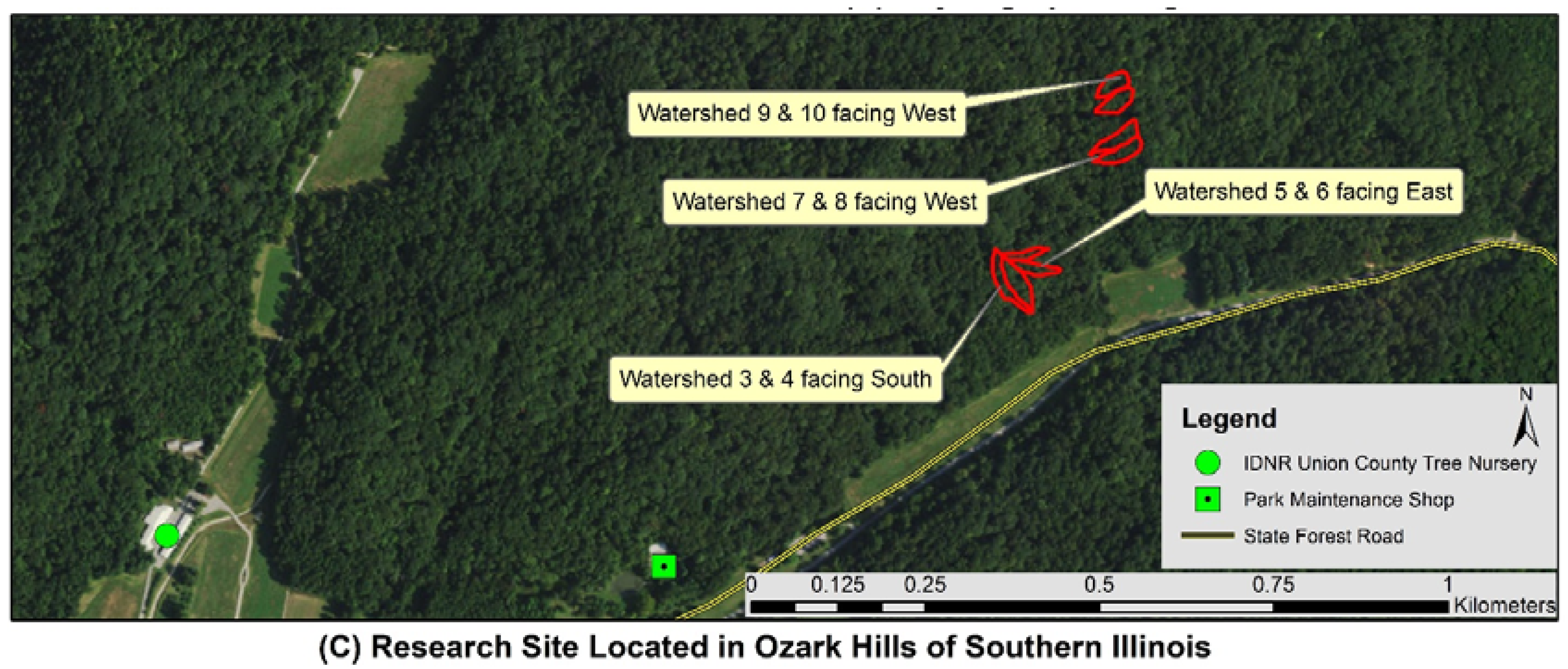

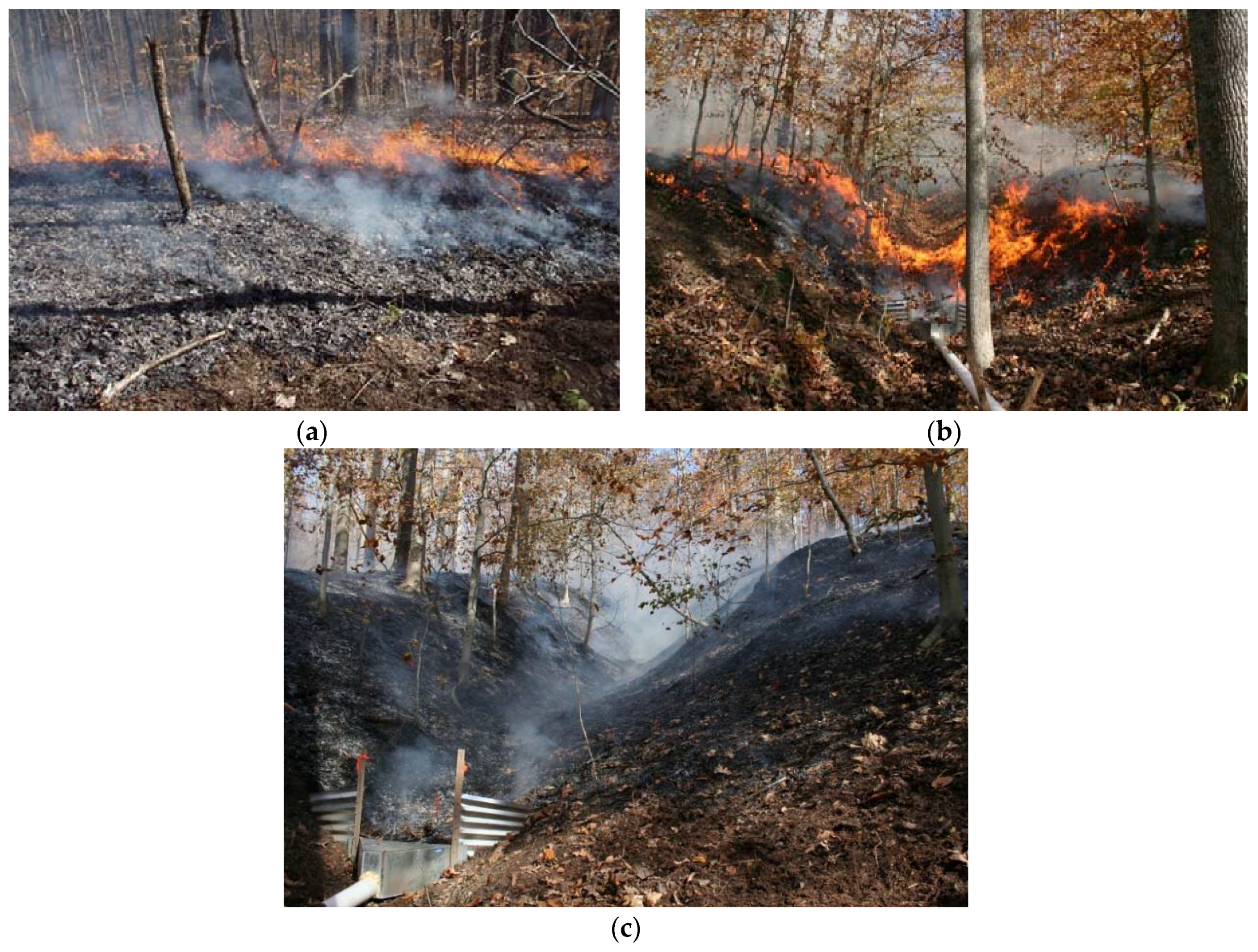
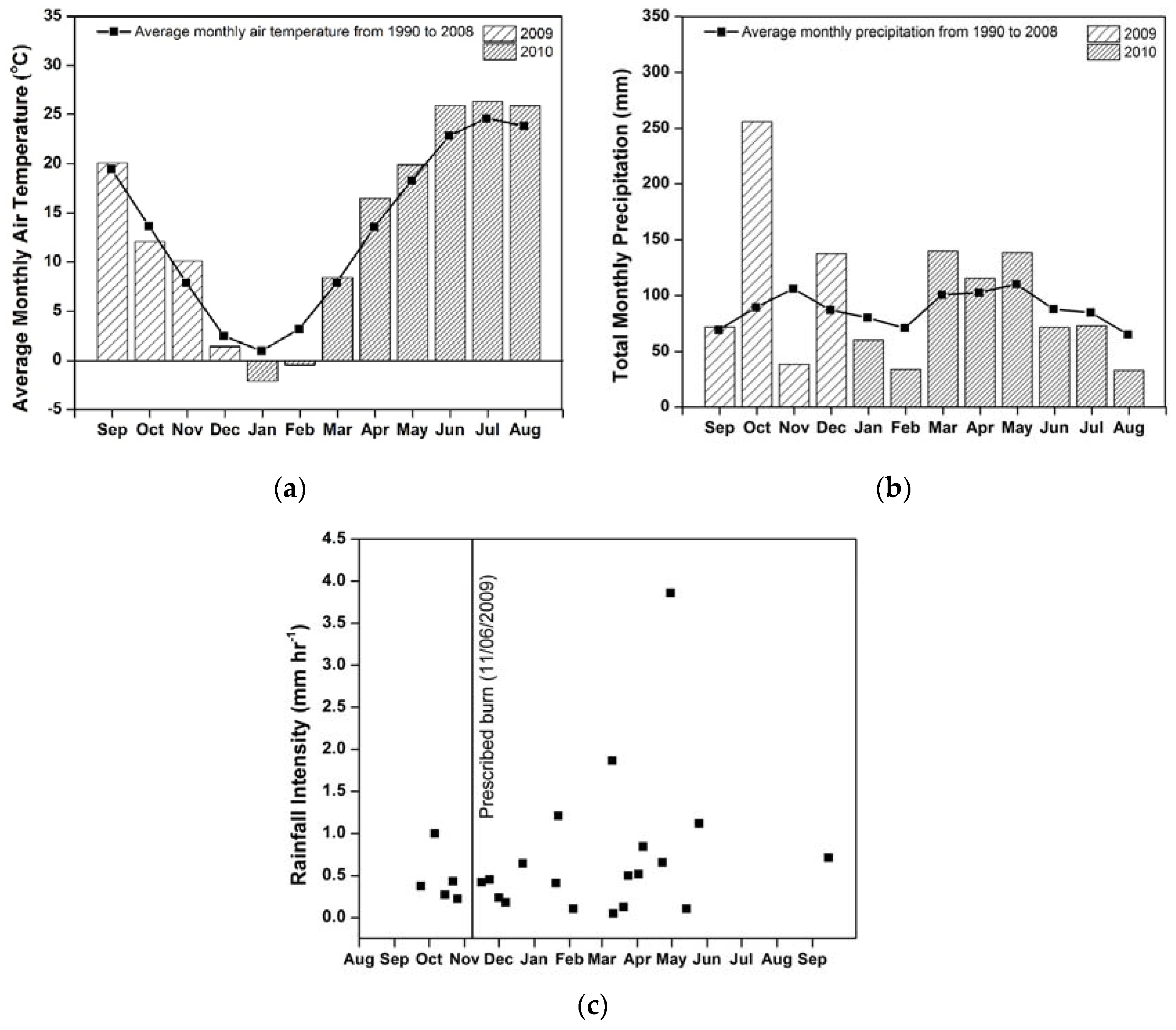
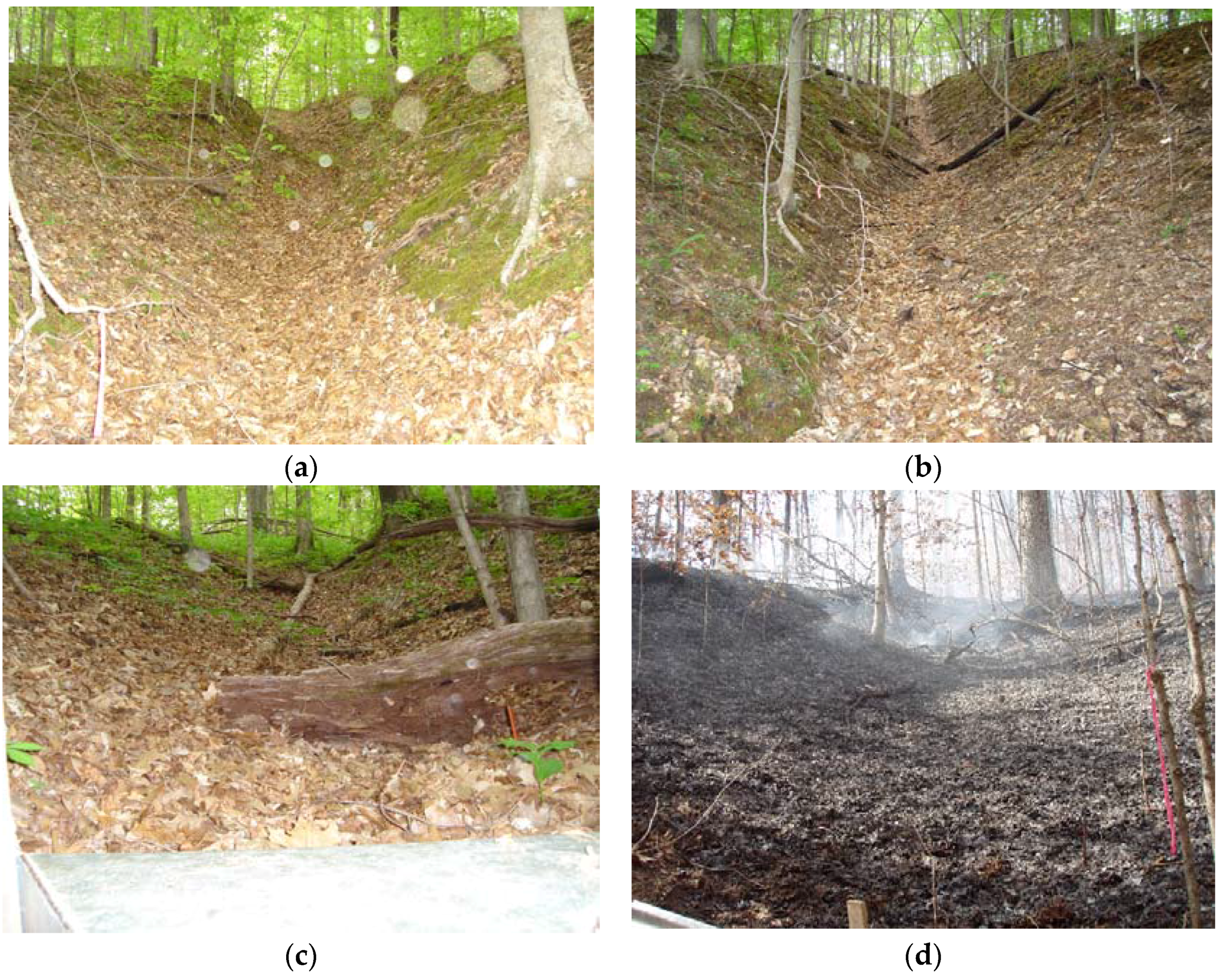
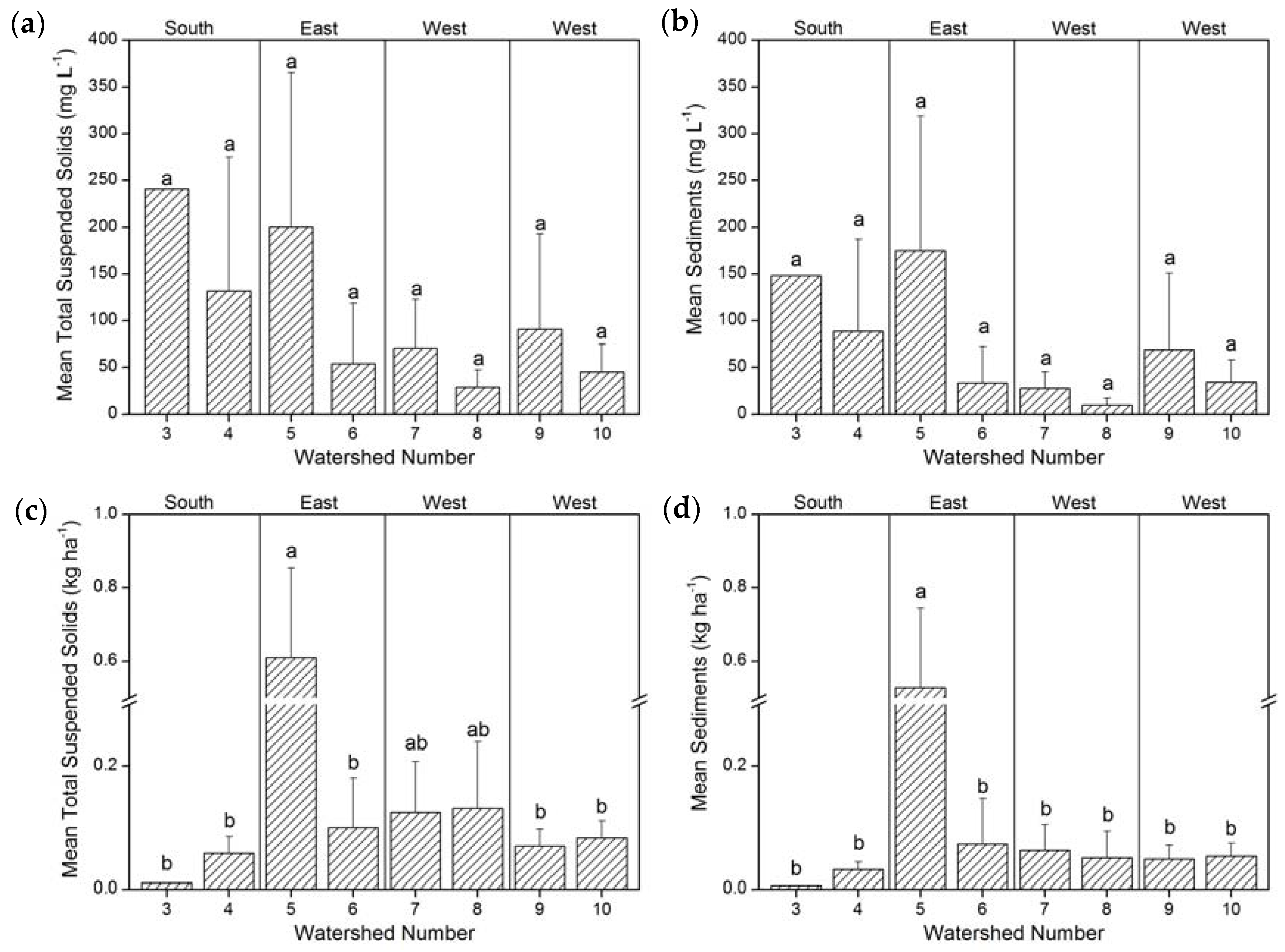
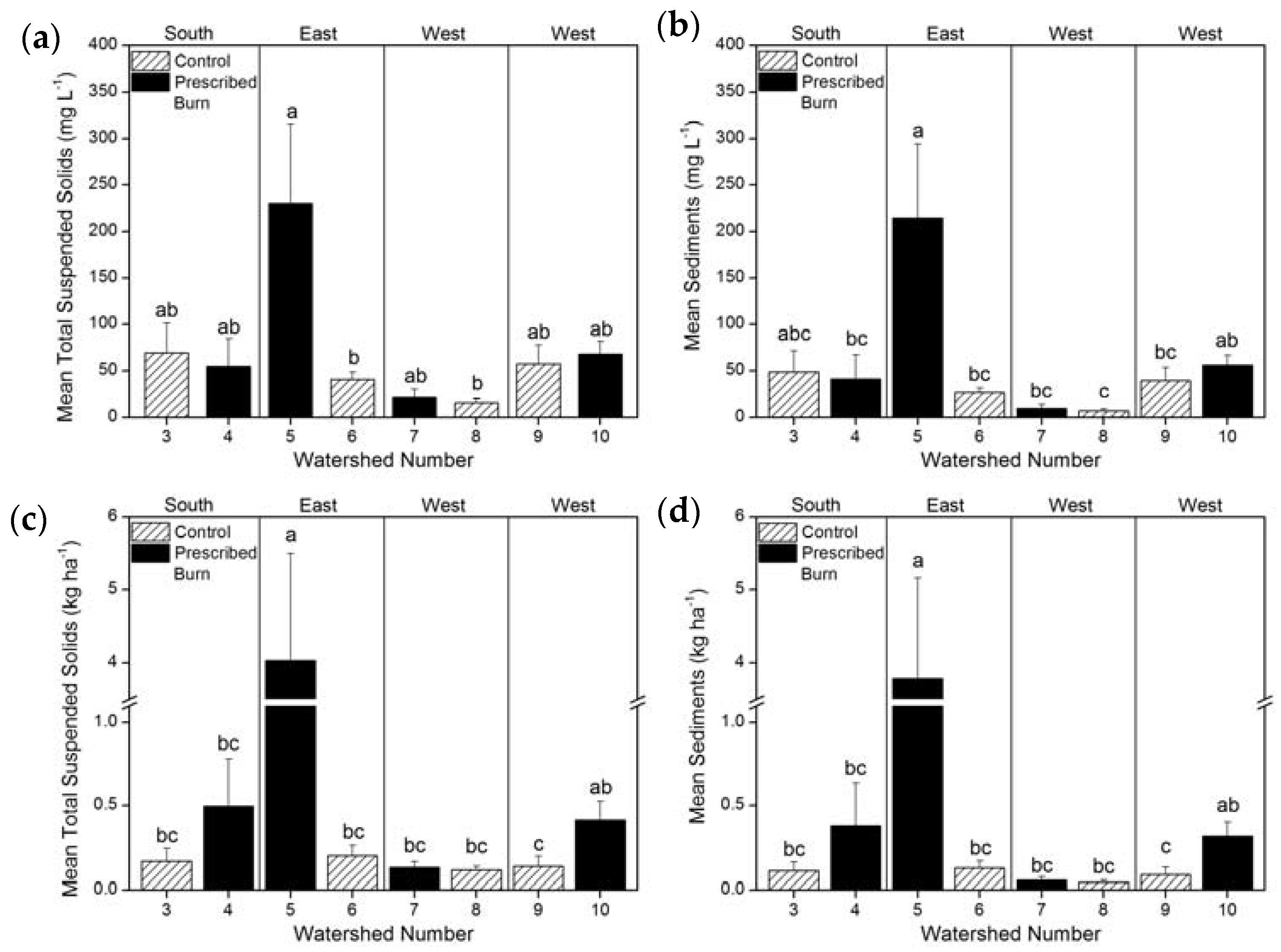
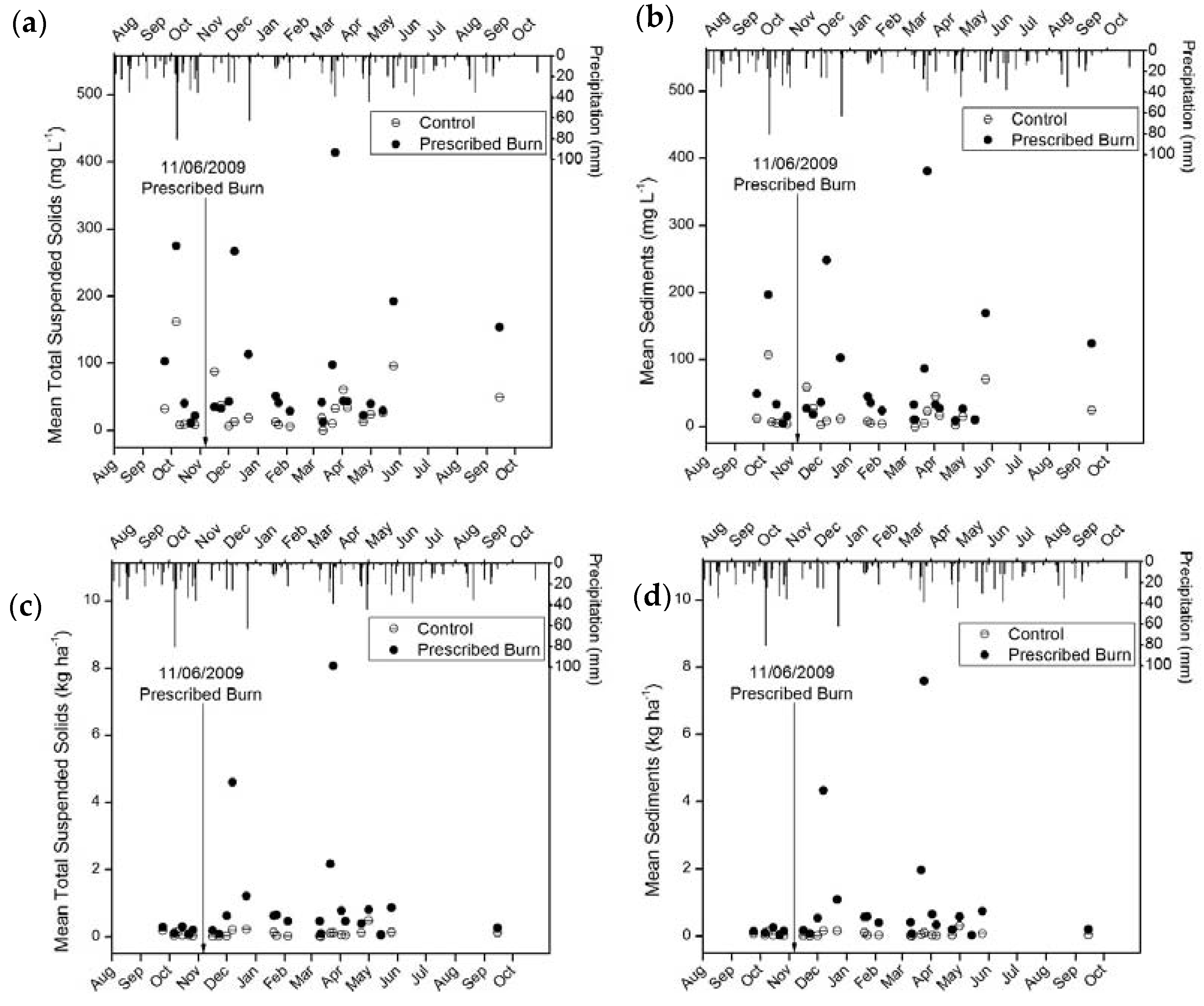
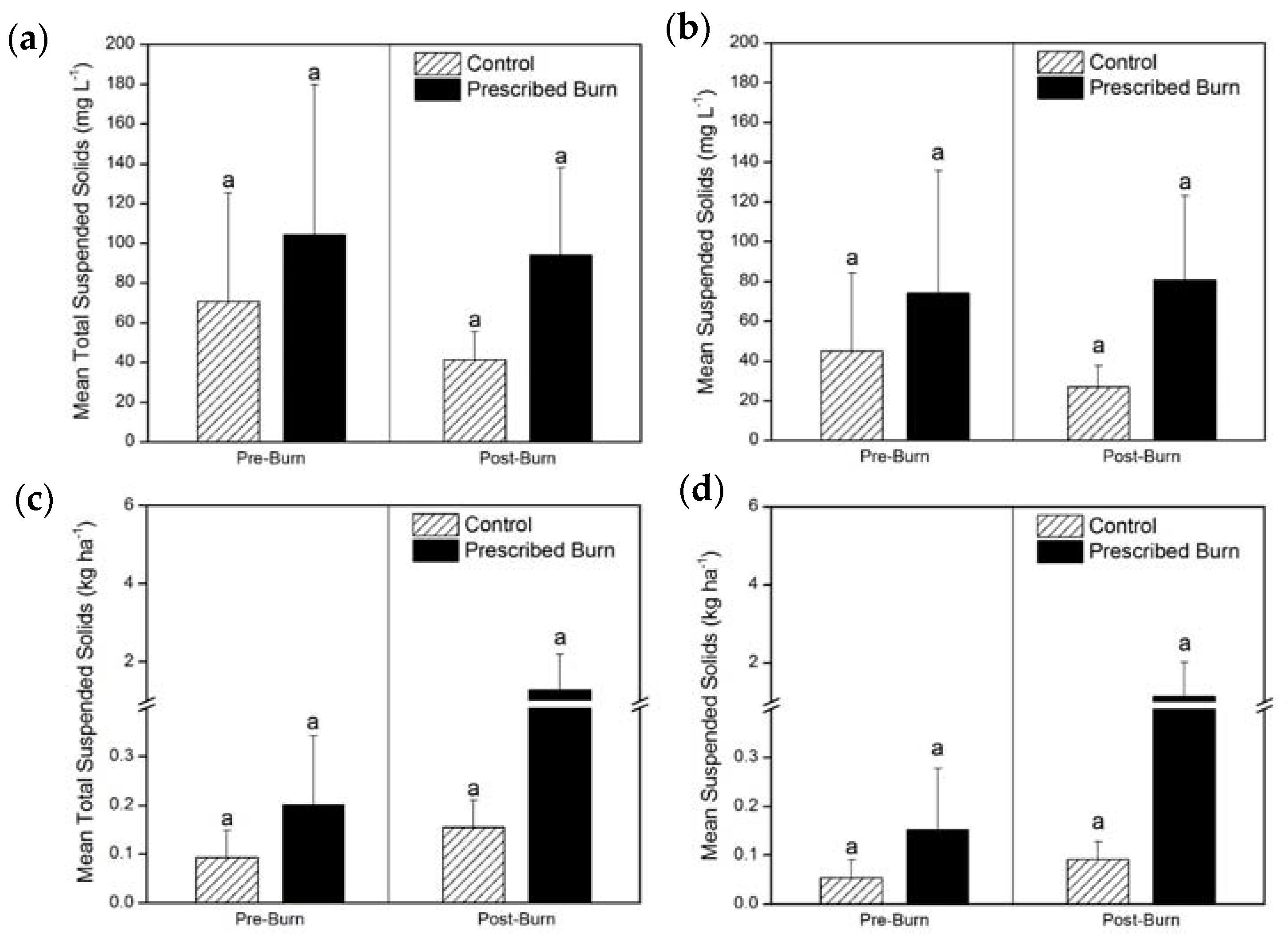
| Landscape Characteristics | Vegetation Characteristics | ||||||||
|---|---|---|---|---|---|---|---|---|---|
| Watershed | Aspect | Average Slope (%) | Slope Range (%) | Elevation Range (m) | Area (ha) | Basal Area (m2·ha−1) | Mature Trees ha−1 (>9 cm) | Saplings ha−1 (2–9 cm) | Seedlings ha−1 (<2 cm) |
| Control | |||||||||
| 3 | South | 18.1 | 5.0–68.8 | 140–169 | 0.11 | 31.1 | 411 | 794 | 9781 |
| 6 | East | 21.3 | 3.4–44.7 | 141–167 | 0.06 | 17.0 | 356 | 1096 | 4109 |
| 8 | West | 24.8 | 2.2–58.3 | 140–169 | 0.11 | 42.6 | 493 | 767 | 21,918 |
| 9 | West | 21.6 | 2.2–45.8 | 155–174 | 0.06 | 31.3 | 384 | 877 | 13,013 |
| Prescribed Burn | |||||||||
| 4 | South | 18.6 | 0.1–42.9 | 140–166 | 0.12 | 54.6 | 493 | 109 | 10,274 |
| 5 | East | 21.6 | 0.0–43.7 | 138–161 | 0.07 | 44.7 | 356 | 329 | 9589 |
| 7 | West | 24.6 | 1.8–72.4 | 141–169 | 0.10 | 38.1 | 548 | 438 | 5479 |
| 10 | West | 18.9 | 1.7–42.8 | 151–171 | 0.09 | 30.7 | 576 | 767 | 5479 |
| Time (CST) | Temp (°F) | Temp (°C) | Relative Humidity (%) | Wind Speed (km·h−1) | Wind Direction |
|---|---|---|---|---|---|
| 1100 | 68.5 | 20.3 | 43 | 3–8 | S-SW |
| 1200 | 74.8 | 23.8 | 39 | 3 | S |
| 1300 | 76.8 | 24.9 | 37 | 6–10 | S |
| Watershed | Mean Temperature (°C) † | Aspect |
|---|---|---|
| 4 | 207.44 ± 12.14 a †† | South |
| 5 | 218.61 ± 26.95 a | East |
| 7 | 281.56 ± 36.39 a | West |
| 10 | 191.77 ± 20.94 a | West |
| Watershed | Average Litter Depth (cm) | Average Volumetric Water Content (%) | ||
|---|---|---|---|---|
| Pre-Burn | Post-Burn | Pre-Burn | Post-Burn | |
| Control | ||||
| 3 | 4.50 a †† | 4.50 a †† | 22.0 ab | 22.2 a |
| 6 | 4.66 a | 4.66 a | 25.2 ab | 24.0 a |
| 8 | 3.92 a | 3.92 a | 22.2 ab | 23.3 a |
| 9 | 3.73 a | 3.73 a | 24.0 ab | 24.0 a |
| Prescribed Burn | ||||
| 4 | 4.77 a | 0.60 b | 26.3 a | 25.8 a |
| 5 | 4.63 a | 0.62 b | 19.8 b | 19.1 a |
| 7 | 4.13 a | 1.34 b | 24.9 ab | 22.6 a |
| 10 | 4.29 a | 1.29 b | 25.6 ab | 25.4 a |
| Watershed | Projected Annual Sediment Loss (kg·year−1) † | Projected Annual Sediment Loss per Ha (kg·ha−1·year−1) | Average Change in Soil Movement per Watershed (mm) † |
|---|---|---|---|
| Control | |||
| 3 | 0.09 | 0.81 | 2.63 ± 1.91 ab †† |
| 6 | 0.16 | 2.54 | −1.32 ± 1.24 ab |
| 8 | 0.11 | 1.04 | 9.89 ± 7.32 b |
| 9 | 0.07 | 1.10 | 0.92 ± 0.64 ab |
| Prescribed Burn | |||
| 4 | 0.53 | 4.34 | 1.84 ± 2.53 ab |
| 5 | 5.97 | 90.54 | −2.68 ± 1.62 ab |
| 7 | 0.15 | 1.41 | −4.19 ± 1.87 a |
| 10 | 0.62 | 6.76 | −2.14 ± 1.53 ab |
| Reference | Location | Land Use | Years † | Annual Precipitation (mm) | Soil Loss (kg·ha−1·year−1) |
|---|---|---|---|---|---|
| Meginnis [57] | Holly Springs, Mississippi | Scrub oak, burned | 2 | 1620 | 740 |
| Oaks, unburned | 2 | 1700 | 56 | ||
| Daniel et al. [58] | Guthrie, Oklahoma | Woodland burned annually | 10 | 780 | 247 |
| Woodland unburned | 10 | 780 | 22 | ||
| Copley et al. [59] | Statesville, North Carolina | Hardwood, burned semi-annually | 9 | 1180 | 6904 |
| Hardwood, unburned | 9 | 1180 | 4 | ||
| Pope et al. [60] | Tyler, Texas | Woodland, burned annually | 9 | 1041 | 807 |
| Woodland unburned | 9 | 1041 | 112 | ||
| Ferguson [61] | East Texas | Shortleaf-loblolly, single burn | 1.5 | - | 471 |
| Shortleaf-loblolly, unburned | 1.5 | - | 224 | ||
| Ursic [50] | North Mississippi | Scrub oak, burned | 3 | 1323 | 568 |
| Scrub oak, unburned | 3 | 1323 | 247 | ||
| Schuman et al. [62] | Treynor, Iowa | Corn, contour farming | 3 | 778 | 25,310 |
| Corn, contour farming | 3 | 774 | 16,600 | ||
| Bromegrass, rotational grazing | 3 | 755 | 600 | ||
| Corn, level terraced farming | 3 | 757 | 1330 | ||
| Sharpley [63] | Southern Plains of Oklahoma and Texas | Grass | >6 | - | 223 |
| Field crops, no-till | >6 | - | 564 | ||
| Field crops, reduced-till | >6 | - | 1275 | ||
| Field crops, conventional-till | >6 | - | 3574 | ||
| Peanut-Sorghum | >6 | - | 16,684 |
© 2017 by the authors. Licensee MDPI, Basel, Switzerland. This article is an open access article distributed under the terms and conditions of the Creative Commons Attribution (CC BY) license (http://creativecommons.org/licenses/by/4.0/).
Share and Cite
Singh, G.; Schoonover, J.E.; Monroe, K.S.; Williard, K.W.J.; Ruffner, C.M. Prescribed Burning and Erosion Potential in Mixed Hardwood Forests of Southern Illinois. Forests 2017, 8, 112. https://doi.org/10.3390/f8040112
Singh G, Schoonover JE, Monroe KS, Williard KWJ, Ruffner CM. Prescribed Burning and Erosion Potential in Mixed Hardwood Forests of Southern Illinois. Forests. 2017; 8(4):112. https://doi.org/10.3390/f8040112
Chicago/Turabian StyleSingh, Gurbir, Jon E. Schoonover, Kyle S. Monroe, Karl W. J. Williard, and Charles M. Ruffner. 2017. "Prescribed Burning and Erosion Potential in Mixed Hardwood Forests of Southern Illinois" Forests 8, no. 4: 112. https://doi.org/10.3390/f8040112






